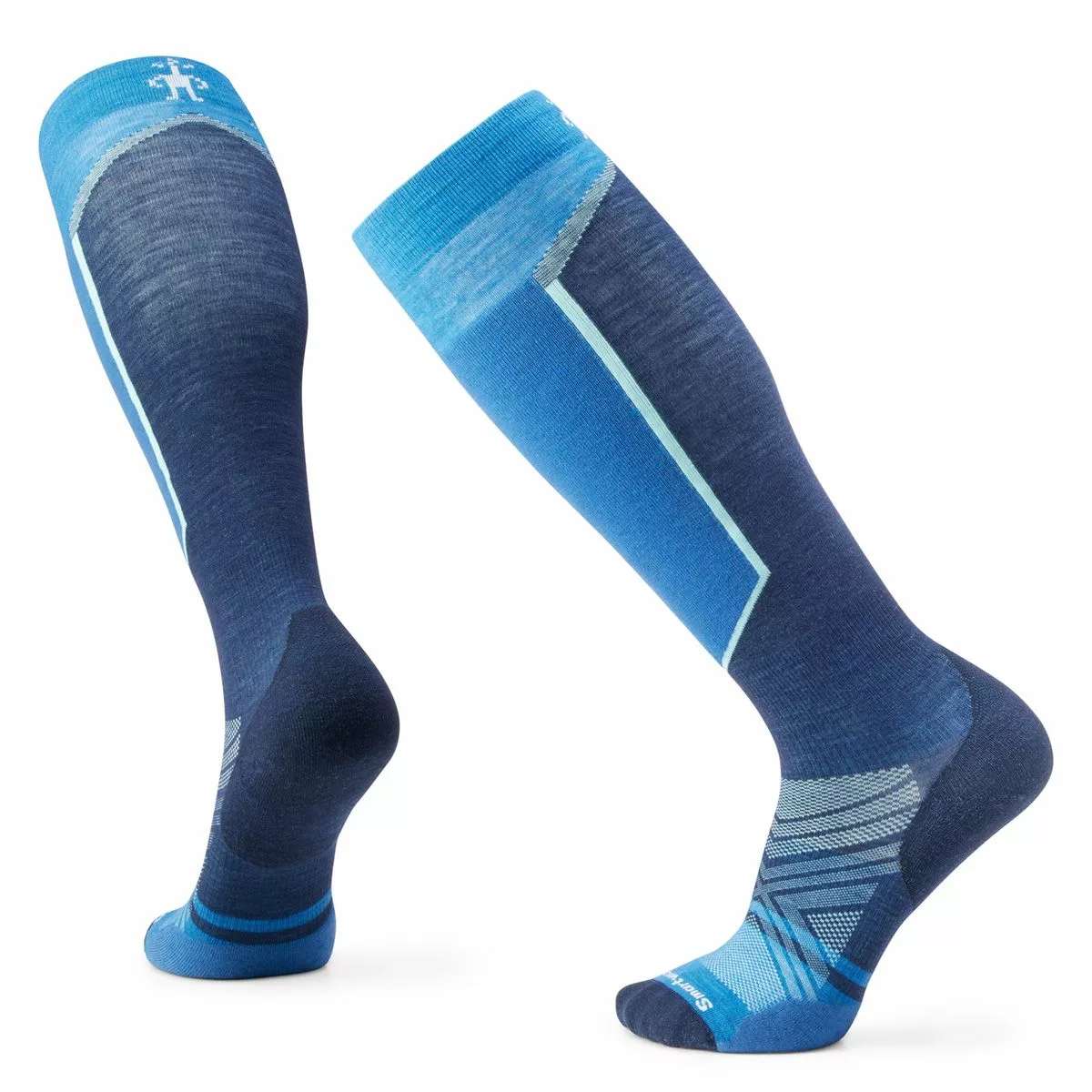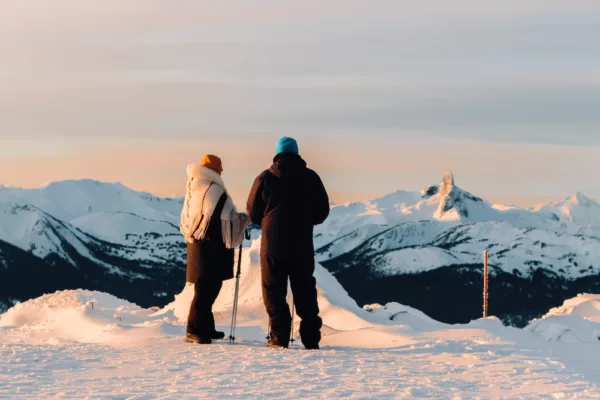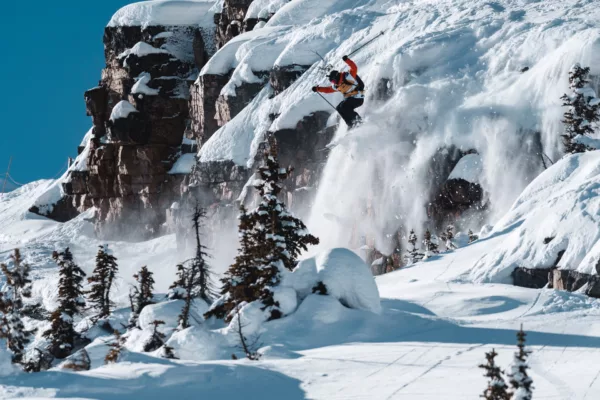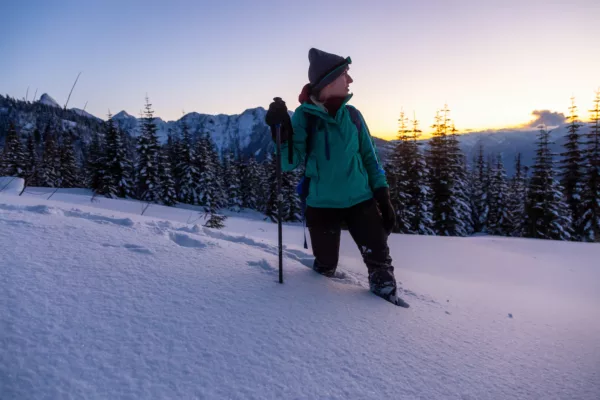What You Need to Go Skiing

If you’re new to skiing or snowboarding, here’s a guide for how to choose your gear.
Whether you are learning to ski or snowboard, having the right gear is essential for a comfortable and enjoyable time on the slopes. Here’s everything you’ll need and how to best equip yourself as a beginner for a seamless experience.
Skis, Boots and Bindings
A set of skis, boots and bindings that are compatible with each other is important for safety and optimal performance on the slopes. Ideal for beginners, all-mountain skis are versatile and can handle various terrains. Though the appropriate ski length depends on your height, weight and skiing ability, the general rule for beginners sticking to groomed slopes is that skis should reach somewhere between your chin and forehead while standing upright, with the width of the skis between 80 and 90 millimetres, measured at their “waist.” Bindings should be compatible with your boots and properly adjusted to your weight and skiing ability. Boots should fit snugly with your heel secured in the heel pocket, and beginners generally benefit from lower-flex-rated boots, between a 60 and 80 flex index, which provide easier control and maneuverability. Evo
Evo
Snowboarders will also need boots, bindings and a snowboard of appropriate length. As a general guideline, a snowboard that reaches somewhere between the chin and nose when standing upright is recommended, and the width of the snowboard should be appropriate for your boot size with little overhang. Bindings should match your boot size and boots should fit snugly.
For beginners who want to wait to invest in gear, rent skis, boots and bindings as a set at resorts or sporting goods retailers. Some resorts, like Grouse and Lake Louise Ski Resort, even offer rental options and package deals for equipment and lessons. Renting or purchasing these items as a package ensures that all components are compatible with each other.
My pick: Rossignol Sender 90 Pro Skis + Xpress 10 Bindings 2024
A Layering System
A layering system consisting of a merino wool base layer, fleece mid-layer, down jacket and waterproof shell and pants provides effective insulation and moisture management as you adapt to changing weather conditions and activity levels. Merino wool base layers regulate body temperature by wicking sweat away from your body, which helps keep you warm in cold conditions and prevents overheating when you’re active.
My pick: Smartwool Classic Thermal Merino Base Layer 1/4 Zip Smartwool
Smartwool
A lightweight and breathable fleece mid-layer provides additional insulation by trapping warm air close to your body. It also retains its insulating properties even when damp.
My pick: Patagonia R1® Air Full-Zip Hoody Patagonia
Patagonia
Down is known for its exceptional warmth-to-weight ratio, providing a high level of insulation in cold conditions. Plus, they’re highly packable, making them convenient for layering when needed.
My pick: Burton [ak] Baker Down Hooded Jacket Burton
Burton
A waterproof shell and pair of waterproof pants act as a barrier against wind, snow and rain, keeping you dry in wet and blustery conditions.
My picks: Eddie Bauer Chair Six Shell Jacket, Eddie Bauer Chair Six Shell Pants Eddie Bauer
Eddie Bauer Eddie Bauer
Eddie Bauer
Other Gear You’ll Need
Socks
Thanks to its moisture-wicking properties, superior insulation and breathability, a pair of merino wool socks will help keep your feet warm and dry.
My pick: Smartwool Ski Targeted Cushion Extra Stretch OTC Socks Smartwool
Smartwool
Waterproof Gloves
Look for gloves that are constructed from durable and high-quality waterproof material, like Gore-Tex. They should fit snugly, as gloves that are too tight can restrict movement while those that are too loose may not keep you warm. If you’re skiing in colder climates, look for gloves with thicker insulation—those with lighter insulation may be preferable in milder weather.
My pick: Dakine Excursion GORE-TEX Mitt Dakine
Dakine
Poles
The right ski poles provide stability and balance. To determine your ideal length, stand with your ski boots on and the poles upside down. Grabbing just beneath the basket, your elbows should form a 90-degree angle. While some poles come with adjustable lengths to adapt to different types of skiing, beginners are often advised to learn proper form and technique without relying on poles.
My pick: Black Crows Meta Ski Poles 2024 Evo
Evo
Daypack
A durable and water-resistant daypack will protect your gear from snow, light precipitation and abrasion. Generally, a daypack with a capacity ranging from 12 to 22 litres is well-suited for a day on the slopes to carry essentials, like water, snacks and extra layers.
My pick: Dakine Heli Pro 20L Backpack Dakine
Dakine
Neck Gaiter
A versatile accessory that can be worn in various ways, a neck gaiter can be used as a hair tie, bandana, balaclava, mask and scarf to protect your face and neck from the cold and sun.
My pick: BUFF Original Neckwear Explore Magazine
Explore Magazine
Helmet
A properly fitting helmet is essential for safety. Looking for a helmet with MIPS (Multi-directional Impact Protection System) helps to enhance head protection by reducing rotational forces during angled impacts. Because helmets are generally designed to protect against a single impact, they should be replaced if they’ve been involved in a significant impact or show signs of damage.
My pick: Flaxta Deep Space MIPS Helmet Flaxta
Flaxta
Goggles
Protect your eyes from wind, cold and UV rays with goggles, using darker or mirrored lenses—such as platinum, gray, black and red lenses for bright and sunny days—and lighter lenses such as yellow or rose for overcast days. For versatile goggles suitable for varied conditions, including both sunny and cloudy days, look for lenses in shades of blue, green or red with a VLT (Visible Light Transmission) between 17 and 30 per cent. Goggles should fit securely on your face and create a proper seal around your eyes. Consider spherical lenses for better peripheral views, as the curve results in less distortion and glare.
My pick: Wildhorn Roca Snow Goggles Wildhorn Outfitters
Wildhorn Outfitters
What To Consider Before You Go
If you’re skiing or snowboarding for the first time, consider taking a lesson from a qualified instructor, as professional guidance can help you learn the basics, proper techniques and safety practices. Also familiarize yourself with the Alpine Responsibility Code, a set of guidelines that include maintaining control of your speed and direction, yielding to skiers and snowboarders ahead of you and staying on marked trails. These guidelines help ensure a respectful and safe experience for all on the slopes.
More Gear Tips on Explore Magazine:
How and Where to Score Ski Gear for Cheap
10 Multi-Purpose Outdoor Gear Items for Every Type of Adventurer
New Ski Gear That Will Make You Stoked for the Winter Season














